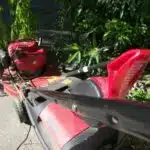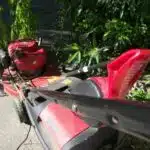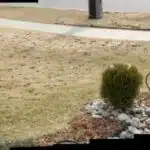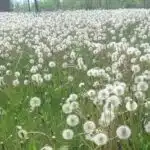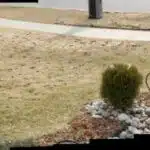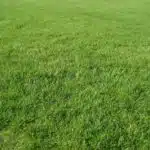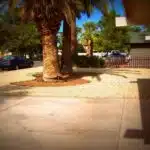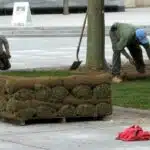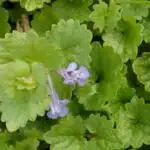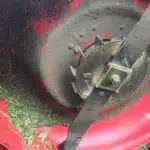As an organic gardening and lawn care expert, I have come across many methods for managing grass growth. However, one of the most effective and natural ways to kill grass is by using newspapers. Not only is this method environmentally friendly, but it can also save you time and money compared to chemical alternatives.
Using newspapers as a weed suppressant has been a common practice for gardeners for years. This technique involves laying down layers of newspaper on top of the grass in areas where you want to prevent further growth. The newspaper acts as a barrier, preventing sunlight from reaching the grass and hindering its ability to photosynthesize effectively. As a result, the grass will eventually die off without the need for harmful chemicals or expensive equipment. In this article, we will explore how to effectively use newspapers to kill grass naturally and provide tips on how to maximize its effectiveness in your lawn care routine.
Understanding The Benefits Of Natural Lawn Care
Picture a lush, green lawn stretching out before you, the grass swaying gently in the breeze. But how did that lawn get that way? Many homeowners resort to chemical lawn care methods to achieve this aesthetic, not realizing the potential harm they may be causing to themselves, their pets, and the environment. Chemical fertilizers, pesticides, and herbicides are known to contaminate water sources, harm wildlife and beneficial insects, and contribute to air pollution. However, transitioning from chemical lawn care to natural methods can have numerous benefits for both your family’s health and the environment.
One of the most significant benefits of natural lawn care is reducing exposure to harmful chemicals. Chemicals used in traditional lawn care methods can linger on your grass for weeks or even months after application, leaving behind residue that can be tracked into your home or ingested by curious children or pets. Natural methods such as composting and mulching allow for slow-release nutrients that won’t harm your family or pets if accidentally ingested.
Another benefit of natural lawn care is the preservation of soil health. Chemical fertilizers can actually strip soil of its natural nutrients over time, leading to a dependence on these artificial inputs and making it harder for plants to grow without them. Natural methods such as composting and topdressing with organic materials help build healthy soil rich in vital nutrients like nitrogen and phosphorus.
For those new to natural lawn care methods, it may seem daunting at first to make the switch from familiar chemical products. However, with some basic knowledge about soil health and plant nutrition, anyone can transition successfully into this more sustainable approach. By doing so, you’ll not only reap numerous benefits but also contribute positively toward protecting our planet from harmful pollutants. Now let’s delve deeper into the environmental impact of chemical lawn care methods.
The Environmental Impact Of Chemical Lawn Care Methods
As we discussed in the previous section, natural lawn care has numerous benefits for both the environment and human health. One of the most significant advantages is reducing the use of harmful chemicals that can pollute our waterways and harm beneficial insects. Chemical treatments also degrade soil quality over time, making it more difficult to maintain a healthy lawn. By transitioning to sustainable landscaping practices, we can mitigate these issues and create a beautiful, thriving outdoor space.
Here are three reasons why reducing chemicals in your lawn care routine is essential:
- Protects wildlife: Many chemical treatments used on lawns can be toxic to birds, bees, and other small animals that rely on healthy green spaces for food and shelter.
- Reduces pollution: Harsh chemicals can leach into groundwater or run off into nearby streams or lakes. This pollution can harm aquatic life and make water unsafe for drinking.
- Saves money: Using eco-friendly methods not only benefits the environment but also your wallet. Organic fertilizers and compost are often less expensive than synthetic alternatives.
If you’re looking to eliminate chemicals from your lawn care routine, using newspapers as a natural weed suppressant is an excellent place to start. Not only is it inexpensive and readily available, but it’s also a practical way to recycle old newspapers while keeping weeds at bay. In the next section, we’ll introduce you to this effective technique so that you can get started creating a healthier, more vibrant lawn today!
Introduction To Using Newspapers For Weed Suppression
As organic gardeners, we understand the importance of caring for our lawn and garden in a way that is safe for the environment. One effective method for controlling weeds is by using newspapers as a natural weed suppressant. Newspapers are an excellent alternative to chemical herbicides because they are cheap, readily available, and harmless to humans and pets.
The benefits of newspaper weed control go beyond environmental safety. By using newspapers to suppress weeds, you can also save time and money on expensive commercial herbicides. Additionally, newspaper mulch helps retain moisture in the soil, which promotes healthy plant growth.
To successfully use newspapers for weed suppression, there are a few tips to keep in mind. First, make sure to use enough layers of newspaper so that no light can penetrate through to the soil below. A good rule of thumb is to use at least six layers of newspaper. Second, wet down the newspaper before laying it over your garden or lawn. This will help prevent it from blowing away or shifting out of place. Lastly, make sure to overlap the edges of each layer by several inches to ensure complete coverage.
By following these tips, you can effectively use newspapers as a natural weed suppressant without harming the environment or spending a lot of money on commercial herbicides. In the next section, we will discuss how to prepare your lawn for newspaper weed control so that you can get started right away!
Preparing Your Lawn For Newspaper Weed Control
After understanding the basics of using newspapers as a natural way to kill grass, it’s time to prepare your lawn. Before laying down newspapers, remove any weeds and debris in the area. You want to create a clear surface for the newspaper to lay on. Next, mow your lawn as short as possible, this will make sure that the newspaper lays flat on the ground and doesn’t wrinkle.
Once you’ve cleared your lawn and mowed it, it’s time to start laying down newspapers. Spread three to four layers of newspaper over your lawn. Make sure that each layer overlaps by two inches or more. This will prevent any grass or weeds from popping through the paper. After laying down the newspaper, wet it thoroughly with water. This helps weigh down the paper and prevents it from blowing away.
While waiting for your grass to die, there are some other things you can do to naturally improve your lawn’s health. Tips for composting and using natural fertilizers can help enrich your soil and promote healthy growth in future plants. Additionally, aerating and overseeding are great ways to promote new growth in areas of your lawn where grass has died off naturally or from using newspapers. By incorporating these practices into your routine, you can have a healthy and vibrant lawn without relying on harmful chemicals.
When choosing the right type of newspaper for weed suppression, there are a few things you should consider such as thickness and color of ink used. It is best to use plain black-and-white newsprint without any glossy inserts or colored ink because these contain harmful chemicals that may leach into your soil over time. By using only plain newsprint paper without any additives or dyes, you can effectively kill grass while also promoting a healthy environment for future plant growth.
Choosing The Right Type Of Newspaper
What type of newspaper should you use to kill grass naturally? Not all newspapers are created equal, and some may not be suitable for organic gardening. The first thing to consider is the ink type used in the paper. Are they made from soy-based or petroleum-based ink? Soy-based ink is considered a safer option as it contains fewer harmful chemicals than its petroleum counterpart. It is better for the environment and your health. Most newspapers today use soy-based ink, but it’s still essential to check.
Another thing to consider when choosing the right newspaper for killing grass is its recycling benefits. Newspapers can have a second life, and recycling them reduces waste in landfills and saves natural resources. If you’re an eco-conscious gardener, look for recycled newspapers that have been printed with soy-based ink. They’re usually labeled as such by the publisher.
Finally, keep in mind that not all papers will work well against grasses. Avoid using glossy or colored sections of newspapers as they contain more chemicals than regular newsprint, which may harm your garden soil’s health. Choose plain black-and-white newspaper sections without glossy finishes instead. By selecting the right type of newspaper, you’ll not only kill grass naturally but also help promote sustainable living practices in your community.
Transitioning into the subsequent section about layering newspapers for optimal effectiveness: Now that you’ve chosen the appropriate newspaper type, it’s time to move on to how you can use them effectively to kill off unwanted grasses in your lawn or garden bed without using harsh chemicals.
Layering Newspapers For Optimal Effectiveness
Now that you have chosen the right type of newspaper, it’s time to focus on layering techniques. The thickness of your newspapers is important because it affects the effectiveness of weed suppression. You want a thick enough layer to block out sunlight, but not so thick that water cannot penetrate through it. It’s recommended to use at least six layers of newspaper, but up to ten layers can be used for better weed control.
Layering newspapers for optimal effectiveness involves covering your entire lawn or garden with the chosen newspapers and ensuring they overlap by about two inches. The overlapping technique helps prevent weeds from growing between the gaps in the paper. Be sure to avoid using glossy pages as they don’t break down as quickly as other pages. If you find that your newspaper layers are too thin, simply add more sheets until you reach the desired thickness.
The next step in properly killing grass with newspapers is wetting them for better adhesion. Before laying down your layers of newspapers, dampen them with water using a hose or spray bottle. Wetting the newspaper helps it adhere better to each other and also prevents them from flying away due to wind or rain. Additionally, watering your lawn or garden before placing down the newspapers will help hold them in place and promote moisture retention in the soil beneath.
Wetting The Newspaper For Better Adhesion
An interesting statistic to consider is that a single newspaper page can hold up to 32 times its weight in water. This means that wetting the newspaper before laying it on the grass can significantly improve adhesion and effectiveness as a natural weed killer. One of the wetting techniques organic gardeners use is to soak the newspapers in water for several hours or overnight. This ensures that the paper is thoroughly saturated and will not dry out quickly, allowing time for the grass underneath to die off.
Another alternative option for wetting the newspaper is to use a garden hose or spray bottle. If using a hose, it is important to use low pressure so as not to tear or move the paper around too much. A spray bottle allows for more precise application, especially if there are areas that need more coverage than others. Regardless of which method you choose, be sure to thoroughly wet each layer of newspaper before placing it on top of the grass.
By wetting the newspaper before laying it down, you are essentially creating a barrier between the grass and sunlight, depriving it of what it needs to grow and thrive. The added benefit of using this natural approach is that over time, as the newspaper breaks down, it will add nutrients back into the soil beneath. In our next section, we will discuss adding soil or mulch on top of the newspaper layer to further aid in this process and create an optimal environment for new growth without harmful chemicals or pesticides.
Adding Soil Or Mulch On Top Of The Newspaper
After laying down the newspaper layer, it’s time to add soil or mulch on top. This step helps to hold the newspapers in place and provides a foundation for new plants. Organic matter such as compost, wood chips, or straw can be used as an alternative material to mulch.
Adding a layer of soil or mulch also assists in long-term sustainability by providing nutrients to the soil. The decomposing organic matter releases essential minerals and microorganisms which contribute to healthy plant growth. This process encourages biodiversity and promotes a thriving ecosystem.
It’s important to remember that adding too much soil or mulch can lead to suffocation of the underlying grass, so it’s essential to monitor the thickness of the layer. A depth of 2-3 inches is sufficient for most plants. Once this step is complete, it’s time to move on to monitoring progress and adjusting as needed.
Monitoring Progress And Adjusting As Needed
The theory that newspaper can kill grass naturally may sound too good to be true for some people. However, it is not just a myth but a proven technique in organic gardening and lawn care. Nevertheless, monitoring progress and adjusting techniques are crucial steps to ensure the success of this method.
Tracking progress is an essential aspect of weed control using newspapers. You need to check the area every few days to see if the newspaper has suppressed the grass or not. If you notice any growth, add more layers of newspaper or wet them thoroughly. For better results, use a mulch on top of the paper, such as wood chips or straw.
Measuring success and adapting methods are vital steps in natural weed control using newspapers. Suppose you find that after several weeks or months, the grass has not died off entirely. In that case, you may need to apply more layers of newspaper or switch to other organic methods such as vinegar spray or corn gluten meal application.
To maximize the effectiveness of newspaper weed control, there are several tips that you can follow. These include ensuring that the area is free from debris before laying down the paper, using thick layers of black and white newspapers (avoid colored ones), watering thoroughly before and after laying down the paper, and covering the paper with a mulch layer. By following these tips and monitoring progress regularly, you will achieve excellent results without harming your lawn or garden naturally.
Tips For Maximizing The Effectiveness Of Newspaper Weed Control
To maximize the effectiveness of newspaper weed control, it is important to ensure that the newspapers cover a large enough area. This means overlapping the newspaper sheets at least two inches to prevent any gaps where sunlight can penetrate. Additionally, using multiple layers of newspaper can also help to increase coverage and suffocate the grass more effectively.
Another issue that organic gardeners often encounter when using newspapers for weed control is slippage. To prevent this, it is recommended to wet the newspaper sheets before laying them down on the grass. This not only helps to keep them in place but also aids in breaking down the paper faster. Some gardeners even opt to apply a layer of mulch or compost over the top of the wet newspapers for added protection against slippage.
In summary, maximizing coverage and preventing newspaper slippage are crucial steps when using newspapers for natural weed control. By following these tips, gardeners can achieve optimal results with minimal effort and without resorting to harmful chemicals. However, it is important to remember that natural lawn care methods may take longer than conventional methods and require patience for best results.
The Importance Of Patience In Natural Lawn Care
To achieve a natural and healthy lawn, patience is an essential trait that must be embraced. The importance of persistence cannot be overemphasized in natural lawn care. In the quest to kill grass naturally using newspapers, it is crucial to give the process sufficient time to work.
Natural weed control methods may not always yield immediate results. Dealing with setbacks and remaining patient with the process can be frustrating, but it is also an opportunity to learn and adjust your approach. Nature works at its own pace, and sometimes all that is needed is a little bit more time for the desired results to manifest.
In conclusion, while natural methods for lawn care can take longer than conventional methods, they are ultimately better for your health and the environment. As you embark on this journey of natural lawn care, remember that patience and persistence are key values in achieving success. In the next section, we will explore some alternatives to newspaper weed control.
Alternatives To Newspaper Weed Control
As effective as newspaper weed control may be, some gardeners may prefer alternative techniques to keep pests at bay. Here are a few gardening tips for natural weed control:
- Mulching: A layer of organic mulch helps suppress weeds by depriving them of sunlight and oxygen. It also enhances soil quality and retains moisture, which is beneficial for plants.
- Hand weeding: Although it requires more effort, manually removing weeds by hand is an efficient method that does not involve chemicals or machinery.
- Organic pest control: Some insects can help control weeds naturally. For example, ladybugs feed on aphids, which are known to damage crops.
It is important to note that these methods require patience and consistent effort for optimal results. However, they are environmentally friendly and sustainable options that promote healthy gardens in the long run.
When it comes to weed control, there are many ways to do it right, but just as many ways to get it wrong. In the next section, we will discuss common mistakes to avoid when using newspapers for weed control.
Common Mistakes To Avoid When Using Newspapers
While newspaper weed control can be an effective and natural way to kill grass, there are some common mistakes that people make when using this method. One of the most frequent mistakes is not using enough newspapers. For the technique to work properly, you need a thick layer of newspaper sheets. Usually, at least five sheets per square foot will suffice.
Another mistake is not watering the newspapers enough after laying them down. The newspapers need to be moist for the grass to die off thoroughly. However, if you overwater the newspapers, they will become too heavy and may blow away or become ineffective against weed growth.
Proper technique when using newspaper weed control involves laying down a thick layer of dampened newspapers on top of your lawn. Then, cover them with a layer of organic mulch or compost for added benefits such as nutrients and moisture retention. Finally, let it sit for several weeks before planting anything new in the area. This waiting period lets the newspapers break down completely and allows their carbon content to enrich your soil.
Moving forward into frequently asked questions about natural lawn care, many people wonder if they should use chemical fertilizers instead of organic ones. While chemical fertilizers may provide quick results, they are ultimately harmful to both your soil and environment in the long run. Organic fertilizers like compost and other plant-based materials offer more sustainable solutions that support healthy soil ecology without any harmful effects on your health or environment.
Frequently Asked Questions About Natural Lawn Care
Natural lawn care is a popular topic among gardeners and homeowners who value environmentally-friendly practices. Many people are concerned about the impact of chemicals on their health and the environment, which has led to an increased interest in natural fertilizers and organic pest control methods. By using these methods, you can maintain a healthy lawn without harming the ecosystem.
Natural fertilizers are a great way to promote plant growth without using synthetic chemicals. They are made from organic materials like compost, bone meal, and fish emulsion, which provide essential nutrients to your lawn. Unlike chemical fertilizers, natural fertilizers release nutrients slowly over time, which means that they won’t burn your lawn or harm beneficial microorganisms in the soil.
Organic pest control is another important aspect of natural lawn care. Chemical pesticides can be harmful to wildlife and humans, as well as beneficial insects like bees and ladybugs. Instead of relying on these harsh chemicals, try using natural pest control methods like companion planting or insect-repelling herbs like mint or lavender. These methods can help deter pests naturally while keeping your lawn healthy and safe for everyone.
As you can see, there are many benefits to adopting a natural approach to lawn care. By using natural fertilizers and organic pest control methods, you can keep your lawn looking beautiful while protecting the environment at the same time. In the following section, we will explore some additional tips for embracing a greener approach to caring for your lawn.
Conclusion: Embracing A Greener Lawn Care Approach
As we have discussed in the previous section, natural lawn care is a popular choice for those who want to maintain their lawns without harming the environment. One way to kill grass naturally is by using newspapers. In fact, according to a recent study, using newspapers as weed barriers can be up to 90% effective in controlling weeds.
Transitioning gradually from chemical lawn care to natural methods can be a daunting task for those who are used to traditional lawn maintenance practices. However, it’s important to consider the pros and cons of chemical lawn care before making the switch. Chemicals such as herbicides and pesticides can harm not only the environment but also human health. Additionally, they can create imbalances in soil pH levels and lead to nutrient deficiencies.
In conclusion, embracing a greener approach to lawn care is not only beneficial for the environment but also for our overall health and well-being. By utilizing natural methods such as using newspapers as weed barriers, we can effectively control weeds without harming ourselves or the environment. So why not make the transition today and start enjoying all the benefits that come with organic gardening and lawn care?
Conclusion
The use of newspapers for weed suppression is a natural and effective method that promotes sustainable lawn care practices. By eliminating the need for harmful chemicals, this approach significantly reduces the environmental impact of traditional lawn care methods. However, it requires proper preparation and execution to achieve optimal results.
When using newspapers as a weed barrier, it is crucial to choose the right type of paper and avoid common mistakes such as leaving gaps or using inadequate layers. Furthermore, alternative natural methods such as mulch or cover crops should also be considered depending on local conditions.
As an organic gardening/lawn care expert, I urge homeowners to embrace a greener approach towards lawn maintenance. Just as we nourish our bodies with healthy food choices, we must prioritize our lawns’ health by adopting natural methods that promote soil health and biodiversity. The use of newspapers for weed suppression is just one example of how we can make a positive impact on our environment while still maintaining beautiful lawns. So let us take the first step towards creating a more sustainable future by incorporating these practices into our lawn care routine. Remember, every small action counts in nurturing an ecosystem that thrives like a garden blooming in springtime.
Image Credits
- “Grass” by eh3k (featured)








